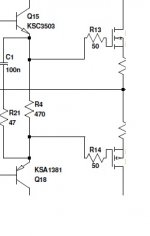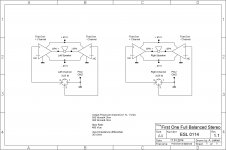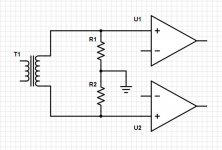My guess would be an added driver stage between the VAS and the output.?...😉
I have already done that last year and used old medium Lateral MOSFET for the driver stage . The sound was good but I have damaged the amp and have not repaired it since then...
Your implementation is of course awesome .Mine was done using modified boards with wiring....
Fab
Most likely like this.
It helps keeping the drive circuit fast enough to lower the switchcurrents in the VAS stage. 😉
- Sonny
Attachments
Last edited:
My guess would be an added driver stage between the VAS and the output.?...😉
I think LC had mentioned about this driver stage. I personally subscribe to the idea of driver stage between VAS and LATFET, but I didn't see it as a mean to lower THD.
I think LC had mentioned about this driver stage. I personally subscribe to the idea of driver stage between VAS and LATFET, but I didn't see it as a mean to lower THD.
My test In spring 2013 gave me 30dB improvement @ 20KHz
LC, how did you select double die mosfets to achieve such a exceptional measurements? And for that matter what about the rest of transistors, did you pair them...maybe?
Hi miksi
Normally those parts are selected carefully but no rocket science here, just pure and simple measurements. Also the second channel confirms the same measurements performance with ease.
Some recipes saved by the author, I'm sure it is understandable and acceptable hehe
Regards, L.C.
Normally those parts are selected carefully but no rocket science here, just pure and simple measurements. Also the second channel confirms the same measurements performance with ease.
Some recipes saved by the author, I'm sure it is understandable and acceptable hehe
Regards, L.C.

Hi,
Is there any particular speaker protection (DC + tempo) that would you recommend to companion the First One?
I suppose a dual mono is preferable over a stereo unit with common ground.
In this category I spotted essentially 2 models version 1 and version 2
Advice welcome.
On another category, I suppose the first one features SE input (although I am not sure since symbo indicates IN+ and IN-). Does anyone came into a good balance to single-ended front-end solution?
Remark: my diy preamp is fully balanced (UGS pass like design) hence the question.
Thanks.
Is there any particular speaker protection (DC + tempo) that would you recommend to companion the First One?
I suppose a dual mono is preferable over a stereo unit with common ground.
In this category I spotted essentially 2 models version 1 and version 2
Advice welcome.
On another category, I suppose the first one features SE input (although I am not sure since symbo indicates IN+ and IN-). Does anyone came into a good balance to single-ended front-end solution?
Remark: my diy preamp is fully balanced (UGS pass like design) hence the question.
Thanks.
Hi Eric
I would choose version 2, since it has the same IC and strong relay. Version 1 has also RLC filter which is not needed in our case, First One has it already.
First One has un-balanced (single ended) input, so if you would like to use your preamp's balanced output than I would suggest you to:
1. use Lundhal line transformer in between or
2. simply use just positive output referenced to GND or
3. use two First One modules per channel in full balanced configuration
Regards, L.C.
I would choose version 2, since it has the same IC and strong relay. Version 1 has also RLC filter which is not needed in our case, First One has it already.
First One has un-balanced (single ended) input, so if you would like to use your preamp's balanced output than I would suggest you to:
1. use Lundhal line transformer in between or
2. simply use just positive output referenced to GND or
3. use two First One modules per channel in full balanced configuration
Regards, L.C.
Hi LC,
Can you show (with a schematic) how we can connect 2 FO in full balanced configuration
and what about with output power at 4 ohms.
The 2 FO must be matched ?
Thanks
Can you show (with a schematic) how we can connect 2 FO in full balanced configuration
and what about with output power at 4 ohms.
The 2 FO must be matched ?
Thanks
Yes, exactly this one. Secondary RC serial load for optimal square wave response. 😉
First One - Full Balanced Stereo
Here are the First One amplifier modules in full balanced stereo configuration.
First One has voltage gain in very tight tolerances, so doesn't need to be extra matched. 😎
Watch the slew rate info.
Hi LC,
Can you show (with a schematic) how we can connect 2 FO in full balanced configuration
and what about with output power at 4 ohms.
The 2 FO must be matched ?
Thanks
Here are the First One amplifier modules in full balanced stereo configuration.

First One has voltage gain in very tight tolerances, so doesn't need to be extra matched. 😎
Watch the slew rate info.

Attachments
I don't think that the balanced circuit in post #95 is going to work very well (and not at all if the source has an audio output transformer). XLR pin #1 is not part of the audio circuit, it is only a shield connection to the chassis.
Hi Speedskater
OK, worse case scenario, galvanic isolation between preamp and First One full balanced amp with transformer coupling. Secondary of the transformer connected to two 10 kOhm input resistors located in each First One channel, referenced to GND, so symmetry of the secondary +/- voltages according to GND potential guarateed. Need more? 🙂
OK, worse case scenario, galvanic isolation between preamp and First One full balanced amp with transformer coupling. Secondary of the transformer connected to two 10 kOhm input resistors located in each First One channel, referenced to GND, so symmetry of the secondary +/- voltages according to GND potential guarateed. Need more? 🙂
Any schematic?
Try to think that sch is the same as transformer's secondary would have two 10 kOhm resistors in series connected to this secondary. Mid point of resistors connected to GND, so symmetry of the secondary voltage to GND is assured in this way. +V and -V have exactly the same potential to GND except that they are inverted. 😉
- Home
- Vendor's Bazaar
- First One - mosFET amplifier module


